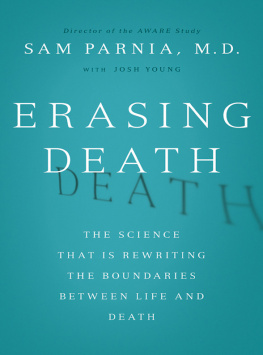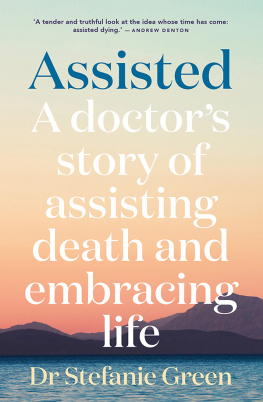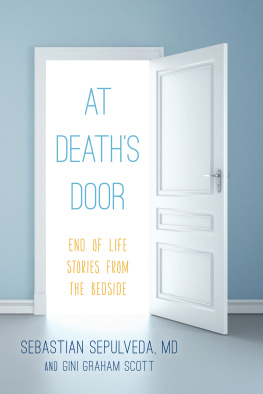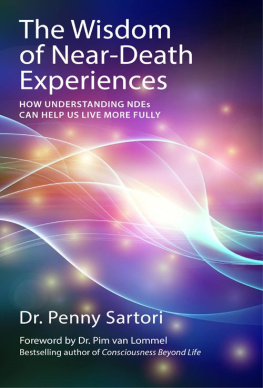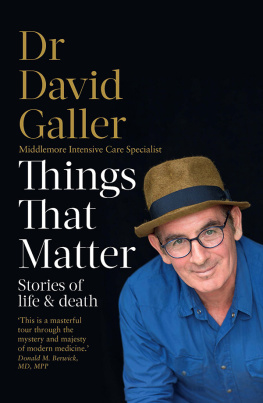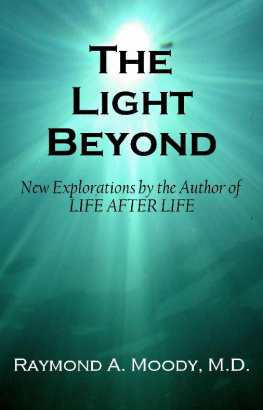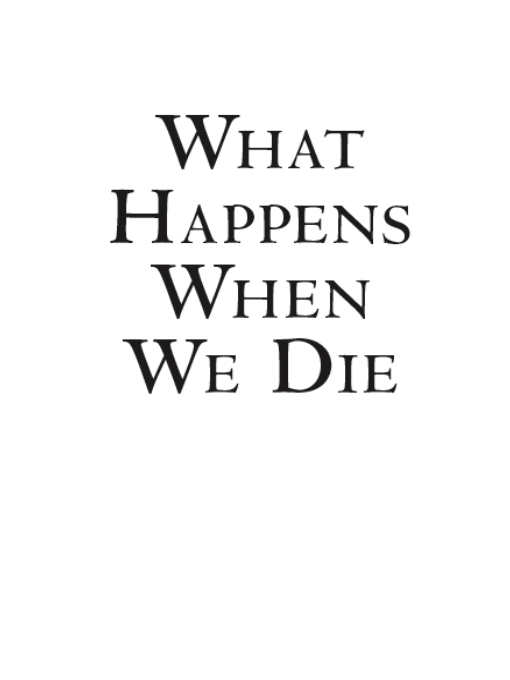
HAY HOUSE TITLES OF RELATED INTEREST
*AFTER LIFE:Answers from the Other Side, by John Edward
CONVERSATIONS WITH THE OTHER SIDE, by Sylvia Browne
DOCTORS CRY, TOO:Essays from the Heart of a Physician,
by Frank H. Boehm, M.D.
EXPERIENCING THE SOUL:Before Birth, During Life, After Death,
by Eliot Jay Rosen
HELP ME TO HEAL:A Practical Guidebook for Patients,
Visitors, and Caregivers, by Bernie Siegel, M.D., and Yosaif August
7 PATHS TO GOD:The Ways of the Mystic,
by Joan Z. Borysenko, Ph.D.
THE UNBELIEVABLE TRUTH:A Mediums Guide
to the Spirit World, by Gordon Smith
*Published by Princess Books; distributed by Hay House

All of the above are available at your local bookstore,
or may be ordered by visiting:
Hay House USA: www.hayhouse.com
Hay House Australia: www.hayhouse.com.au
Hay House U.K.: www.hayhouse.co.uk
Hay House South Africa: www.hayhouse.co.za
Hay House India: www.hayhouse.co.in
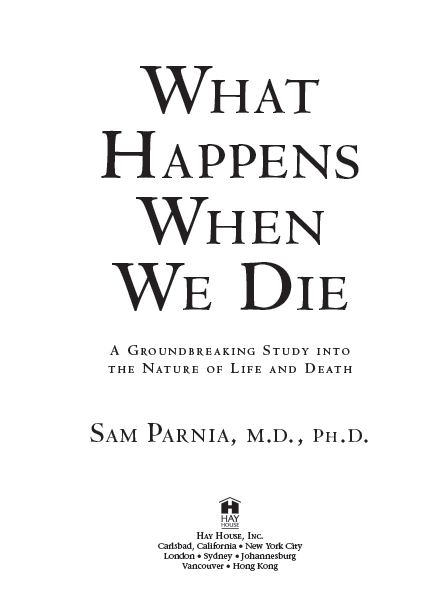
Copyright 2006 by Sam Parnia
Published and distributed in the United States by: Hay House, Inc.: www.hayhouse. com Published and distributed in Australia by: Hay House Australia Pty. Ltd.: www.hayhouse.com.au Published and distributed in the United Kingdom by: Hay House U.K., Ltd.: www.hayhouse.co.U.K. Published and distributed in theRepublic of South Africa by: Hay House SA (Pty), Ltd.: www.hayhouse.co.za Distributed in Canada by: Raincoast: www.raincoast.com Distributed in Indiaby: Hay House Publishers India: www.hayhouse.co.in
Design: Amy Gingery Indexer: Richard Comfort
All rights reserved. No part of this book may be reproduced by any mechanical, photographic, or electronic process, or in the form of a phonographic recording; nor may it be stored in a retrieval system, transmitted, or otherwise be copied for public or private useother than for fair use as brief quotations embodied in articles and reviews without prior written permission of the publisher.
The author of this book does not dispense medical advice or prescribe the use of any technique as a form of treatment for physical or medical problems without the advice of a physician, either directly or indirectly. The intent of the author is only to offer information of a general nature to help you in your quest for wellbeing. In the event you use any of the information in this book for yourself, which is your constitutional right, the author and the publisher assume no responsibility for your actions.
The names of all individuals who have had NDEs have been changed to protect their confidentiality.
Library of Congress Cataloging-in-Publication Data
Parnia, Sam.
What happens when we die : a groundbreaking study into the nature of life and
death / Sam Parnia,.
p. cm.
Includes bibliographical references and index.
ISBN-13: 978-1-4019-0710-5 (hardcover)
ISBN-10: 1-4019-0710-5 (hardcover)
ISBN-13: 978-1-4019-0711-2 (tradepaper)
ISBN-10: 1-4019-0711-3 (tradepaper)
1. Near-death experiences. 2. Thanatology. I. Title.
BF1045.N4P37 2006
133.9013--dc22
2005022482
Tradepaper ISBN 13: 978-1-4019-0711-2
Tradepaper ISBN 10: 1-4019-0711-3
11 10 09 08 5 4 3 2
1st printing, January 2006
2nd printing, November 2008
Printed in the United States of America

This book is dedicated to my mother, Soraya,
who has patiently taught and encouraged me
in all my endeavors throughout my life.

CONTENTS

Ascent into the Empyreanpanel from an altarpiece thought to be of the Last Judg-ment (oil on panel), Bosch, Hieronymus (c.14501516)/Palazzo Ducale, Venice, Italy (Bridgeman Art Library)
I t requires a special kind of scientist to ask the question What happens when we die? One thing is certain, and that is that we shall all die. But in our culture, we tend to ignore the fact of our mortality, and it is usually only when a close friend or family member is dying that we uneasily acknowledge our own inevitable progression toward death.
This is a subject that for thousands of years has largely been a question for philosophical debate rather than objective scientific exploration, but in recent times science has started to advance our understanding of what happens when we die, both physiologically and in terms of the human mind.
The work of Dr. Raymond Moody and the publication of his book Life After Life in 1972 suggested that there was a set of phenomena that he termed the near-death experience, which might provide some clues about what we experience at the end of life. However, the difficulty with this early data on near-death experiences (NDEs) was that although many people who had indeed been near death described them, the full potential of the NDE was not understood by scientists, who saw it as just another mental state that could easily be explained by our current scientific understanding of brain function.
It took the foresight, understanding, and sensitivity of Dr. Sam Parnia to see the full potential of the NDE and the contribution it could make to our understanding of death and dying. He also realized its significance with respect to the most crucial problem now faced by neurosciencethe nature of consciousness. His profound realization was that our best understanding of death and dying could be achieved by only studying those NDEs that occurred during cardiac arrest (when the heart stops, and after 11 seconds, consciousness and brain electrical activity cease) so that no areas of brain function remain that could support consciousness. Even the very basic life-supporting systems are destroyed; and respiration, cardiac output, and brain-stem life-support reflexes are all absenta state equivalent to clinical death. Dr. Parnia saw that this state, which remains reversible for about 30 minutes, is the closest model that science can have of the dying process and provides a unique window for understanding what we all experience at the end of life.
One of the most interesting features of the near-death experience during cardiac arrest is that upon recovery, patients sometimes report leaving their bodies and watching the resuscitation process. Although many researchers have argued against their validity, workers have now suggested that many of these accounts accurately describe what actually happened. This anecdotal evidence suggests that during the time that brain function was absent, the patient not only had experiences, but was also able to remember them, even in the absence of brain processes. This is a startling possibility. Dr. Parnia single-handedly attempted to examine these claims in a preliminary study by hiding targets on the ceiling of the coronary-care unit in hospital wards in Southampton to see whether they would be reported in out-of-body claims. This in itself tells us a great deal about himnot many doctors would have been courageous or determined enough to persuade their cautious and conservative medical colleagues to agree to this, and only a scientist who had a true vision for his scientific research would have attempted it.
Next page

